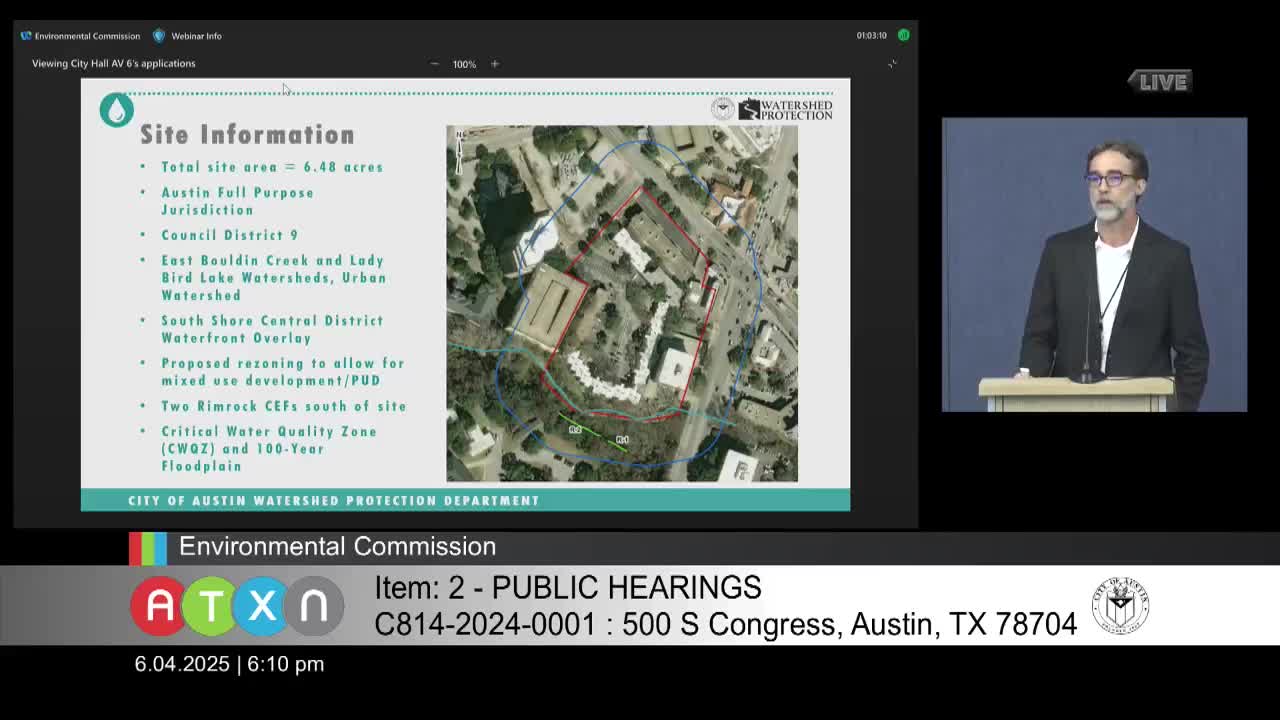Austin Council reviews mixed-use development and environmental impact near Bolden Creek
June 04, 2025 | Austin, Travis County, Texas
This article was created by AI summarizing key points discussed. AI makes mistakes, so for full details and context, please refer to the video of the full meeting. Please report any errors so we can fix them. Report an error »

In a pivotal meeting held at Austin City Hall, the Environmental Commission delved into a proposed Planned Unit Development (PUD) that promises to reshape a significant area of the city while addressing critical environmental concerns. The proposal, which includes a mix of residential, commercial, and recreational spaces, aims to balance urban growth with the preservation of vital ecological zones.
The development plan outlines the construction of 950 residential units, a 225-key hotel, and 600,000 square feet of office space, alongside 155,000 square feet dedicated to retail and restaurants. Notably, the project is designed to exceed current open space requirements by 10%, ensuring that the community benefits from ample green areas amidst the urban landscape.
Central to the discussions was the impact on water quality and floodplain management. The proposed site is situated near East Bolden Creek, which is classified as a critical water quality zone and falls within a 100-year floodplain. The developers plan to enhance the floodplain volume by 25,000 cubic feet, improving its functionality and habitat quality. This initiative is expected to elevate the floodplain's health from a fair to a good condition, a significant step towards ecological restoration.
The meeting also highlighted the importance of tree preservation. A detailed tree plan was presented, indicating the removal of diseased trees while proposing the relocation of heritage trees to nearby open spaces. This careful consideration of existing flora reflects a commitment to maintaining the area's natural beauty and biodiversity.
In terms of sustainability, the development aims to incorporate green stormwater infrastructure, including rain gardens and cisterns, to manage water quality effectively. The proposal includes modifications to existing codes to facilitate these environmentally friendly practices, ensuring that at least 50% of water quality requirements are met through sustainable methods.
The commission's recommendations for approval emphasize the need for compliance with various environmental standards, including a reduction in impervious cover from 48.2% to 20.7%. This reduction is crucial for minimizing runoff and enhancing the ecological integrity of the area.
As the meeting concluded, the commission's discussions underscored a growing recognition of the need to harmonize urban development with environmental stewardship. The proposed PUD not only aims to meet the demands of a growing population but also seeks to foster a sustainable future for Austin, setting a precedent for future developments in the region.
The development plan outlines the construction of 950 residential units, a 225-key hotel, and 600,000 square feet of office space, alongside 155,000 square feet dedicated to retail and restaurants. Notably, the project is designed to exceed current open space requirements by 10%, ensuring that the community benefits from ample green areas amidst the urban landscape.
Central to the discussions was the impact on water quality and floodplain management. The proposed site is situated near East Bolden Creek, which is classified as a critical water quality zone and falls within a 100-year floodplain. The developers plan to enhance the floodplain volume by 25,000 cubic feet, improving its functionality and habitat quality. This initiative is expected to elevate the floodplain's health from a fair to a good condition, a significant step towards ecological restoration.
The meeting also highlighted the importance of tree preservation. A detailed tree plan was presented, indicating the removal of diseased trees while proposing the relocation of heritage trees to nearby open spaces. This careful consideration of existing flora reflects a commitment to maintaining the area's natural beauty and biodiversity.
In terms of sustainability, the development aims to incorporate green stormwater infrastructure, including rain gardens and cisterns, to manage water quality effectively. The proposal includes modifications to existing codes to facilitate these environmentally friendly practices, ensuring that at least 50% of water quality requirements are met through sustainable methods.
The commission's recommendations for approval emphasize the need for compliance with various environmental standards, including a reduction in impervious cover from 48.2% to 20.7%. This reduction is crucial for minimizing runoff and enhancing the ecological integrity of the area.
As the meeting concluded, the commission's discussions underscored a growing recognition of the need to harmonize urban development with environmental stewardship. The proposed PUD not only aims to meet the demands of a growing population but also seeks to foster a sustainable future for Austin, setting a precedent for future developments in the region.
View full meeting
This article is based on a recent meeting—watch the full video and explore the complete transcript for deeper insights into the discussion.
View full meeting
